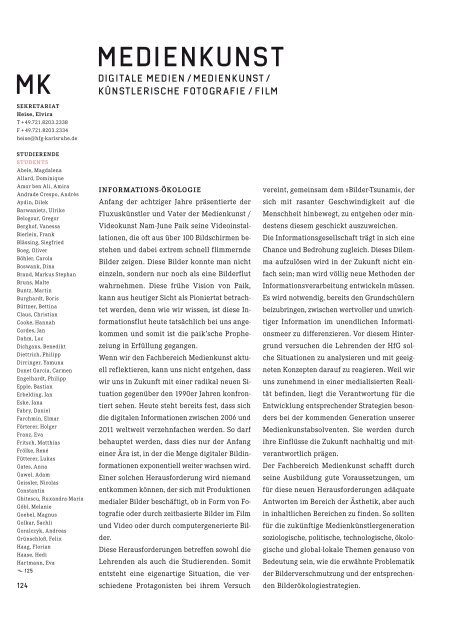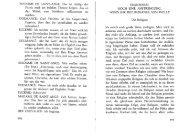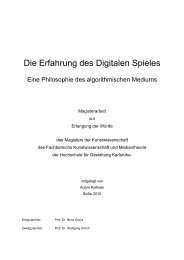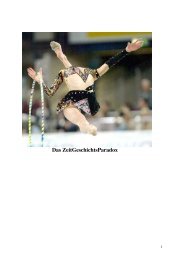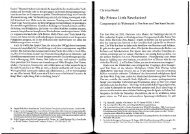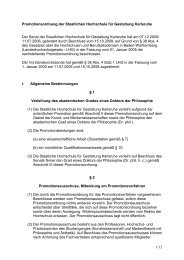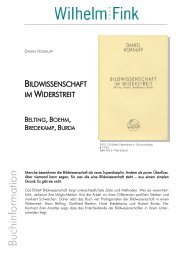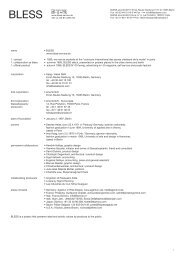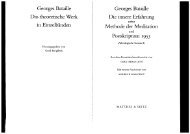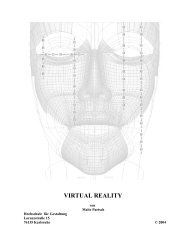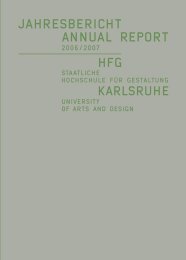jahresbericht annual report - Staatliche Hochschule für Gestaltung ...
jahresbericht annual report - Staatliche Hochschule für Gestaltung ...
jahresbericht annual report - Staatliche Hochschule für Gestaltung ...
Sie wollen auch ein ePaper? Erhöhen Sie die Reichweite Ihrer Titel.
YUMPU macht aus Druck-PDFs automatisch weboptimierte ePaper, die Google liebt.
M K<br />
Sekretariat<br />
Heise, elvira<br />
T + 49.721.8203.2338<br />
F + 49.721.8203.2334<br />
heise@hfg-karlsruhe.de<br />
Studierende<br />
StudentS<br />
Abele, Magdalena<br />
Allard, Dominique<br />
Amor ben Ali, Amira<br />
Andrade Crespo, Andrès<br />
Aydin, Dilek<br />
Barwanietz, Ulrike<br />
Belogour, Gregor<br />
Berghof, Vanessa<br />
Bierlein, Frank<br />
Blässing, Siegfried<br />
Boeg, Oliver<br />
Böhler, Carola<br />
Boswank, Dina<br />
Brand, Markus Stephan<br />
Bruns, Malte<br />
Buntz, Martin<br />
Burghardt, Boris<br />
Büttner, Bettina<br />
Claus, Christian<br />
Cooke, Hannah<br />
Cordes, Jan<br />
Dahm, Luc<br />
Dichgans, Benedikt<br />
Diettrich, Philipp<br />
Dirringer, Yamuna<br />
Donet Garcia, Carmen<br />
Engelhardt, Philipp<br />
Epple, Bastian<br />
Erbelding, Jan<br />
Eske, Jana<br />
Fabry, Daniel<br />
Farchmin, Elmar<br />
Förterer, Holger<br />
Franz, Eva<br />
Fritsch, Matthias<br />
Frölke, René<br />
Fütterer, Lukas<br />
Gates, Anna<br />
Gawel, Adam<br />
Geissler, Nicolas<br />
Constantin<br />
Ghitescu, Ruxandra-Maria<br />
Göbl, Melanie<br />
Goebel, Magnus<br />
Golkar, Sachli<br />
Goralczyk, Andreas<br />
Grünschloß, Felix<br />
Haag, Florian<br />
Haase, Hedi<br />
Hartmann, Eva<br />
= 125<br />
124<br />
M E D I E N KUNST<br />
D I G I TAL E M E D I E N / M E D I E N K U N ST /<br />
K Ü N STL E R I S C H E F OTO G R AF I E / F I L M<br />
infOrmatiOnS-ÖkOlOgie<br />
Anfang der achtziger Jahre präsentierte der<br />
Fluxuskünstler und Vater der Medienkunst /<br />
Videokunst Nam-June Paik seine Videoinstallationen,<br />
die oft aus über 100 Bildschirmen bestehen<br />
und dabei extrem schnell flimmernde<br />
Bilder zeigen. Diese Bilder konnte man nicht<br />
einzeln, sondern nur noch als eine Bilderflut<br />
wahrnehmen. Diese frühe Vision von Paik,<br />
kann aus heutiger Sicht als Pioniertat betrachtet<br />
werden, denn wie wir wissen, ist diese Informationsflut<br />
heute tatsächlich bei uns angekommen<br />
und somit ist die paik’sche Prophezeiung<br />
in Erfüllung gegangen.<br />
Wenn wir den Fachbereich Medienkunst aktuell<br />
reflektieren, kann uns nicht entgehen, dass<br />
wir uns in Zukunft mit einer radikal neuen Situation<br />
gegenüber den 1990er Jahren konfrontiert<br />
sehen. Heute steht bereits fest, dass sich<br />
die digitalen Informationen zwischen 2006 und<br />
2011 weltweit verzehnfachen werden. So darf<br />
behauptet werden, dass dies nur der Anfang<br />
einer Ära ist, in der die Menge digitaler Bildinformationen<br />
exponentiell weiter wachsen wird.<br />
Einer solchen Herausforderung wird niemand<br />
entkommen können, der sich mit Produktionen<br />
medialer Bilder beschäftigt, ob in Form von Fotografie<br />
oder durch zeitbasierte Bilder im Film<br />
und Video oder durch computergenerierte Bilder.<br />
Diese Herausforderungen betreffen sowohl die<br />
Lehrenden als auch die Studierenden. Somit<br />
entsteht eine eigenartige Situation, die verschiedene<br />
Protagonisten bei ihrem Versuch<br />
vereint, gemeinsam dem »Bilder-Tsunami«, der<br />
sich mit rasanter Geschwindigkeit auf die<br />
Menschheit hinbewegt, zu entgehen oder mindestens<br />
diesem geschickt auszuweichen.<br />
Die Informationsgesellschaft trägt in sich eine<br />
Chance und Bedrohung zugleich. Dieses Dilemma<br />
aufzulösen wird in der Zukunft nicht einfach<br />
sein; man wird völlig neue Methoden der<br />
Informationsverarbeitung entwickeln müssen.<br />
Es wird notwendig, bereits den Grundschülern<br />
beizubringen, zwischen wertvoller und unwichtiger<br />
Information im unendlichen Informationsmeer<br />
zu differenzieren. Vor diesem Hintergrund<br />
versuchen die Lehrenden der HfG solche<br />
Situationen zu analysieren und mit geeigneten<br />
Konzepten darauf zu reagieren. Weil wir<br />
uns zunehmend in einer medialisierten Realität<br />
befinden, liegt die Verantwortung <strong>für</strong> die<br />
Entwicklung entsprechender Strategien besonders<br />
bei der kommenden Generation unserer<br />
Medienkunstabsolventen. Sie werden durch<br />
ihre Einflüsse die Zukunft nachhaltig und mitverantwortlich<br />
prägen.<br />
Der Fachbereich Medienkunst schafft durch<br />
seine Ausbildung gute Voraussetzungen, um<br />
<strong>für</strong> diese neuen Herausforderungen adäquate<br />
Antworten im Bereich der Ästhetik, aber auch<br />
in inhaltlichen Bereichen zu finden. So sollten<br />
<strong>für</strong> die zukünftige Medienkünstlergeneration<br />
soziologische, politische, technologische, ökologische<br />
und global-lokale Themen genauso von<br />
Bedeutung sein, wie die erwähnte Problematik<br />
der Bilderverschmutzung und der entsprechenden<br />
Bilderökologiestrategien.<br />
M e d ia Art<br />
D I G I TAL M E D I A / M E D I A A RT /<br />
A RT I S T I C P H OTO G RA P H y / F I L M<br />
infOrmatiOn ecOlOgy<br />
At the beginning of the 1980s, flux artist and father of media art / video art, Nam June Paik, presented<br />
his video installations, which often consist of more than 100 screens and show extremely<br />
fast flickering images. These images could not be perceived individually, but only as a flood of<br />
images. From today’s perspective, Paik’s early vision can only be considered the deed of a pioneer:<br />
for as we know, this flood of information has indeed become true today, and thus Paik’s<br />
prophecy has been fulfilled.<br />
When reflecting on the current situation of the Department of Media Art, we can hardly overlook<br />
the fact that, in comparison with the 1990s, we face a radically new situation in the future.<br />
It’s already apparent today that digital information worldwide will have increased tenfold between<br />
2006 and 2011. It is safe to say that this is only the beginning of an era, in which the volume<br />
of digital image information will continue to grow exponentially. None who deals with the<br />
production of media images, whether in the form of photography, or via time-based images in<br />
film and video or via CGI, will be able to evade these challenges.<br />
They affect teachers as much as students. This creates a strange situation that unites different<br />
protagonists in their joint attempt to either flee the “image tsunami” moving towards humanity<br />
at breathtaking speed, or at least to skillfully dodge it.<br />
This information society as such is as much an opportunity as a threat. Solving this dilemma in<br />
the future will not be easy; entirely new methods of information processing will have to be developed.<br />
It will become necessary to teach even elementary-school students how to distinguish<br />
between the valuable and the trivial in this unlimited sea of information. In this context, professors<br />
and lecturers at the HfG are attempting to analyze such situations and to develop suitable<br />
concepts to respond to them. Since we increasingly find ourselves living in a media-dominated<br />
reality, the responsibility for developing appropriate strategies will rest on the shoulders of the<br />
coming generation of our Media Art graduates. They will share the responsibility of sustainably<br />
shaping the future.<br />
The education at the Department of Media Art provides a well-founded basis for finding adequate<br />
answers to these new challenges in the field of aesthetics, yet also in content-related<br />
fields. Future generations of media artists should thus place importance not only on sociological,<br />
political, technological, ecological, and global / local issues, but as previously mentioned,<br />
also on the problem of image pollution and corresponding image-ecology strategies.<br />
M A<br />
SecretarieS’ Office<br />
Heise, elvira<br />
T +49.721.8203.2338<br />
F + 49.721.8203.2334<br />
heise@hfg-karlsruhe.de<br />
=<br />
Herrmann, Oliver<br />
Hinsch, Christoph-Robin<br />
Höntzsch, Julia<br />
I, Seon Yeong<br />
Israel, Samuel<br />
Ivaz, Vladimir<br />
Jantsch, Wolfram<br />
Jilg, Melanie<br />
Kersting, Johannes<br />
Kindermann, Lukas<br />
Klar, Katrin Agnes<br />
Kleinschmidt, Hauke<br />
Klinkhammer, Oskar<br />
Koch, Justin<br />
Kretschmer, Kilian<br />
Kugel, Marco<br />
Kuhlig, Anna<br />
Kühn, Thomas<br />
Lai, Christoph<br />
Lara Roloff, Andrea<br />
Lawrenz, Tobias<br />
Lorenz, Martin<br />
Loscher, David<br />
Maia Jost, Iuri<br />
Matweew, Kevin<br />
Menrad, Nils<br />
Meyer, Florian<br />
Morine, Mitsuharu<br />
Murakami, Wataru<br />
Nestor, Constantin<br />
Ochs, Kilian<br />
Olczak, Nina<br />
Quack, Simon<br />
Reinhart, Jakob<br />
Roguski, Grazyna<br />
Rosinski, Stefan<br />
Rübensaal , Stefanie<br />
Rybakov, Mikhail<br />
Schachenhofer, Ursula<br />
Schall, Julius<br />
Schmidt, Marianne<br />
Schöner, Steffen<br />
Schumann, Jan<br />
Schwanninger, Thorsten<br />
Schwarz, Lorenz<br />
Sieverding, Orson<br />
Stasevic, Bozena<br />
Stober, Jens Moritz<br />
Stürmer, Eduard<br />
Teufel, Christiana<br />
Teuscher, Marc<br />
= 126<br />
125


